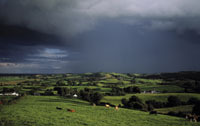First came the potato blight, but could wheat be Ireland’s next major crop to succumb to uncontrollable fungal infection? writes Steven Kildea
The expansion of intensive agriculture has undoubtedly contributed to our current living standards and expectations. Our ability to intensively plant and manage fields with single crops has brought excellent rewards in terms of yield increases, with vast fields of golden wheat stretching beyond the horizon coming to symbolise the success of modern agriculture. However, such monocultures lack the flexibility and resilience of more diverse stands and can be more prone to attack from pests and diseases
The greatest disease threat to European wheat crops
Wheat, the most important food crop globally, has an assortment of pests and diseases that can quickly turn a high yielding crop into one of little or no value. Currently, Septoria tritici leaf blotch (STB), caused by the fungal pathogen Mycosphaerella graminicola, is possibly the greatest disease threat to European wheat crops. A disease that thrives in wet temperate conditions, M. graminicola is a big problem in northwestern Europe; nowhere more so than in Ireland, with its long history of hardships associated with crop devastation, including the notorious potato blight famine of the 1840s.
Although the temperate Irish climate provides the potential for wheat crops to achieve some of the highest yields in the world, these are often not realised due to diseases such as STB. If left untreated, STB can cause yield losses as high as 50%. Fortunately, intensive fungicide programmes mean that the disease is kept under control and yield losses are kept to a minimum. However, stricter fungicide registration processes within the European Union – in particular the change in how the potential threat of pesticides to human health is assessed – coupled with the potential of plant pathogens to develop resistance, are reducing the fungicidal armoury available to farmers to thwart diseases.
The most notable loss of fungicides against STB in recent years has been the QoIs or strobilurins, which succumbed to resistance in 2002 and 2003. Commercially released in the mid-1990s, the strobilurins were a novel group of fungicides that acted on their target pathogens by depriving them of energy. As energy is a vital component in all living organisms, their selective ability and potency made them excellent fungicides. It took but a single change in the DNA of M. graminicola to undo the exceptional strength of the strobilurins.
Since 2003, controlling M. graminicola and STB in Ireland has become dependent on a selection of the demethylation-inhibitor (DMI) fungicides backed up by the older fungicide, chlorothanoil. Chlorothalonil is excellent at preventing disease, and has been an important part of fungicide programmes for decades, but it is solely a protectant fungicide that has virtually no use if applied after infection. Its activity is also nonsystemic and confined largely to the area where it is directly applied.
Understanding how STB reduces wheat yields can help with the selection of fungicides suitable for STB control. Wheat yields are determined by the ability of the plant to photosynthesise during the summer, primarily in the upper leaves and plant head. Dead tissue or ‘necrotic lesions’ resulting from STB reduce the green leaf area available for photosynthesis and thus the aim of most foliar disease control programmes is to ensure these leaves remain disease-free. As Ireland’s summer months tend to be relatively warm, but at the same time wet, there can be a constant disease pressure, with emerging leaves often susceptible to an immediate attack.
Furthermore, poor weather conditions often result in delayed fungicide applications, potentially leaving crops unprotected for a period of time. Fungicides that provide protection at the application site or through systemic movement through the plant, while also providing a level of curative action, are ideal candidates. A selection of DMI fungicides, specifically epoxiconazole and prothioconazole, tick these boxes and hence they have become vital to Irish wheat production.
The emergence of strobilurin resistance and dramatic breakdown in their efficacy against M. graminicola throughout northwestern Europe dramatically highlighted a specific vulnerability within our crop management systems. Although unlikely that we could have prevented the emergence of resistance, knowledge of such events may have allowed its rapid spread to have been controlled. With this in mind, the Irish Food and Agriculture Development Authority (Teagasc) initiated a fungicide sensitivity survey in 2002 of Irish M. graminicola populations. The aim was to ensure that if changes occur in the sensitivity of populations to the most active DMIs, or future chemistries, we can take measures to possibly prevent or reduce selection for these strains. This survey has continued to the present day and to date over 1500 strains of M. graminicola from the main wheat growing regions of the country have been assessed.
shift in sensitivity to epoxiconazole

Analysis of the strains detected a mutation in the target gene and retrospective analysis of samples collected in previous years’ surveys showed these strains had been present at an extremely low frequency. Clearly, selection for these strains had occurred in the specific crop during 2008.
In the spring 2009 collection, we found that these particular strains had become more widespread, albeit at a low frequency bar the one crop we had identified them in the previous year. On the basis of these findings we issued precautionary recommendations to Irish farmers, with an emphasis on minimising the selection of these particular strains while ensuring disease control and yields. Any shift in sensitivity to fungicides is a worrying development for farmers and needs to be taken seriously – unless it is towards a more sensitive population, which very rarely occurs!
During the summer of 2009, the majority of the survey sites sampled showed no change in sensitivity to that recorded in spring, with new strains present but at low frequencies. Selection for these strains did, however, occur in two of the survey sites, with the frequency increasing to over 50% of the field population. We are still examining the reasons for this selection and whether it is related to fungicide usage.
While we worry about sensitivity changes in the M. graminicola populations and how they may affect disease control, changes in the registration of fungicides may have an equally dramatic effect on disease control. There is speculation in recent months that a number of DMI fungicides will be lost following the implementation of new European pesticide regulations. Among the fungicides, which could be withdrawn, is epoxiconazole, one of the most important M. graminicola fungicides we currently have available.
If farmers in Ireland presently had neither epoxiconazole nor prothioconazole available to them, the profitability of wheat production here would be highly questionable. We are reliant on these fungicides to produce wheat of both the quality and quantity needed to be profitable. True, the expected registration of newer succinate dehydrogenase inhibitor (SDHI) fungicides in coming years will hopefully alleviate some of the reliance we have on epoxiconazole and prothioconazole. However, in the often wet environment that is Ireland, we need all methods of disease control available!
Steven Kildea is a research officer at the Teagasc Crops Research Centre, Oak Park, Carlow, Ireland.





